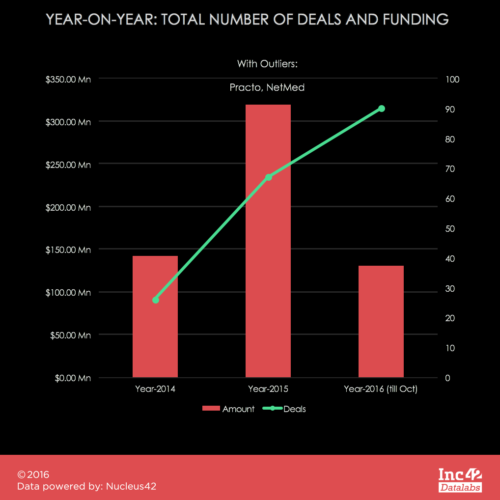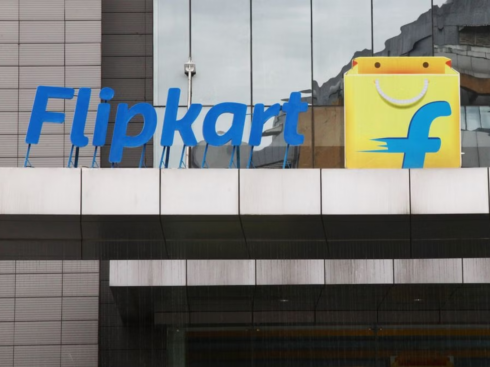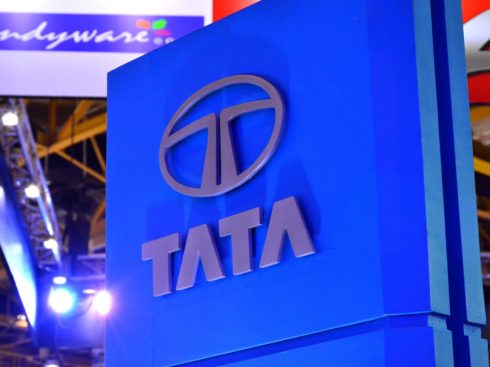
[Note: This article is part of The Junction Series. Get a deep dive on innovations in HealthTech and the Indian startup ecosystem. Learn more about The Junction here!]
Consider the following stats about India’s healthcare from Portea Medical:
- 2 Mn is the gap in bed capacity.
- ~75% is the population without health insurance.
- ~315 Mn are affected by tropical diseases.
- <1% of healthcare delivery providers are accredited.
- ~3 Tn is the cumulative healthcare spending required by 2025
- ~ 3 Tn is the number of urban diseases patients that receive adequate treatment out of ~ 38 Mn patients.
- India’s population is evolving and ageing, with the geriatric age group expected to constitute 11% share by 2025 rising to 20% or 300 million elders by 2050. Of this number, 200 million (elders) will be afflicted by Non-Communicablele Diseases (NCDs).
- Although rural India accounts for about 70% of the population, it has less than one-third of the nation’s hospitals, doctors and beds.
While there are no two ways to deny that our healthcare record is still far from satisfactory, it also can’t be denied that, today, digital technology is enabling us to reduce that gap. Thanks to it, many healthtech platforms have mushroomed, which are slowly making the consumer more aware of his health and the steps he can take to track it.
So, earlier, if ways to measure health parameters were only available with a doctor or at a hospital, that information is now available on the consumer’s mobile phone. Devices from glucometers to credit card-sized devices for tracking cardiac diseases to wearables, are enabling more and more people to keep track of their health.

As per Inc42, this year 90 startups were funded in the healthtech space with a total $129.85Mn flowing in, till October 2016. While this points to a trend that healthtech may be the VCs next favourite, for startups, the path to success in this field is filled with sizeable obstacles.
From getting people to divulge data and enter the same on an ongoing basis; from convincing doctors to give a shot to new healthtech devices; cracking a monetisation model, to simply ensuring more adoption – decoding healthtech is hardly as easy as decoding ecommerce.
Inc42 spoke to some of the players in the healthtech space to get a comprehensive view of the impediments that stand in the uptake of healthtech technologies in India.
The Trust Factor
Healthcare, like fintech, is one sector where the trust factor is probably the most important criterion which influences adoption. Health is a very personal, private, and sensitive matter, and any healthtech startup will have to ensure that their offering takes into account the need for patient privacy.
 Saurabh Arora, founder & CEO, Lybrate, a mobile-first healthcare information, access and delivery platform states that any online health platform has to ensure privacy is maintained, and trust is built. “Before starting up Lybrate, we thoroughly examined the concerns that has limited the adoption of health-tech platforms and fixed them.”
Saurabh Arora, founder & CEO, Lybrate, a mobile-first healthcare information, access and delivery platform states that any online health platform has to ensure privacy is maintained, and trust is built. “Before starting up Lybrate, we thoroughly examined the concerns that has limited the adoption of health-tech platforms and fixed them.”
He adds that it is natural for users to be sceptical about their details leaking out. Thus, in order to maintain patient privacy, the Lybrate platform keeps all the information of users safe and anonymous. Expect for vital details necessary for diagnosis, contact information (mobile and email address) is not revealed to the doctor.
First time users have limited trust on online platforms. Thus, steps need to be taken to build trust by ensuring complete transparency in terms of fees disclosures.
Dhruv Suyamprakasam, founder of online consultation platform iCliniq, also concurs. Dhruv adds, “Constant ‘trust’ building with the customer is important. Every customer, be it the doctor or a patient, who uses the product has to be taken into account. There are hundreds of good health-tech services/products which failed because of not taking efforts to build ‘trust’ by the entrepreneur.”
Keeping The Doctor Away
The best way for healthcare platform to become successful is adoption by doctors, who can then prescribe it to patients. Hence, making it easy to use and understand is the need of the hour. But healthtech startups sometimes seem to miss that point.
 Explains Dhruv, “The biggest problem with the entrepreneur in the healthtech industry is that they miss three important things viz. not involving the doctor, marketing the service/product like other industries, and lack of trust-building with the customer. The whole healthcare system revolves around the doctor as various consumer studies have shown that a ‘patient trusts the doctor’s opinion’ than any technology and patients ‘adopt’ health-tech only if their doctor suggests it.”
Explains Dhruv, “The biggest problem with the entrepreneur in the healthtech industry is that they miss three important things viz. not involving the doctor, marketing the service/product like other industries, and lack of trust-building with the customer. The whole healthcare system revolves around the doctor as various consumer studies have shown that a ‘patient trusts the doctor’s opinion’ than any technology and patients ‘adopt’ health-tech only if their doctor suggests it.”
He explains that entrepreneurs have to closely work with ‘doctors’ to make a healthtech product/service or evolve that product with ‘doctor’s feedback. Being in the healthtech business without involving the doctor is detrimental.
And this is exactly what Lybrate had in mind while designing the platform. Reveals Saurabh, “We made it super easy for doctors to adopt the platform by replicating it with something they were already familiar with. We gave the platform a WhatsApp-like look and feel, so that doctors did not have the hiccups of using something new.”
Meena Ganesh, MD and CEO, Portea Medical, also concurs that awareness and acceptability are a challenge when it comes to healthtech. She says, “Doctors are not comfortable dispensing treatment or advice without meeting patients and vice–versa with patients still prefer the conventional method of in-person meetings.”
Vipin Pathak, co-founder and CEO of home health care startup Care24 also seconds this. He cites reluctance of medical, nursing, and other staff to adjust to change and apprehensions around technology failures and confidentiality concerns of the consumer, as well as many providers as one of the major barriers for large-scale adoption.
The Cost Factor

While technology adaptation is picking up fast, costs remain a barrier. Meena, explains, “Innovation is still being driven by the US and costing is based on this and most devices are manufactured abroad. Therefore, adjusting costs to the local environment is still a factor.”
Added to that, is the huge infrastructure requirement in a country like India. Meena adds that in India, in general, bandwidth is a huge issue. Reliability and costs are prohibitive. The reliability of power is also a question which brings up the difficulties in handling remote healthcare monitoring.
Sumeet Khanna, founder Surgivisor, an online discovery platform for patients advised surgery, states,
“By nature, the healthcare sector needs a lot of initial capital investments, market research, regulatory clearances etc., which makes this sector very challenging. There is no doubt that healthcare tech is the new big thing today, but sluggish growth in the industry especially for the startups, monetisation, due to weak (non-sustainable) revenue model, low government assistance and protection, are the major factors contributing to its low adoption in our country.”
Girish Mehta, India CEO Medgenome, also airs the same view. He states, “With new technology, there is no kind of indigenisation available. These are very expensive technologies and are available to people at a very high cost. And not everyone can afford it.”
Low Government Involvement
One of the major issues with new healthtech technologies is poor awareness about them. So much so that, sometimes, even doctors are not aware of the same. For instance, Girish points out that most of doctors don’t even know about genomics. And in his opinion it is the the government that has done nothing to improve the overall situation.
He explains, “ Medical college curriculum does not include the latest kinds of innovation in healthtech, and how can they be utilised. Their curriculum is still 10 to 15 years behind. This means that people coming out of medical colleges have to learn about these things on the job. This is difficult for them given the hectic and stressed lifestyles most of the doctors lead.”
He believes that the government itself needs to invest a lot in the sector. Right now, it has left the entire new technology adoption to the private sector.
 The same sentiments are echoed by Sumeet who states that the Indian government allocates very less budget for healthcare spending, thereby resulting in infrastructure issues of standard diagnostic procedures, clinics, health IT systems etc. He adds, “The Indian government also plays an important role in running several health insurance programmes and actively regulates the private insurance markets. However, there is a dearth of such programmes for the population below poverty line.”
The same sentiments are echoed by Sumeet who states that the Indian government allocates very less budget for healthcare spending, thereby resulting in infrastructure issues of standard diagnostic procedures, clinics, health IT systems etc. He adds, “The Indian government also plays an important role in running several health insurance programmes and actively regulates the private insurance markets. However, there is a dearth of such programmes for the population below poverty line.”
Meena too expresses similar views. Citing stats, she states, “Public healthcare spending in India is already among the lowest in the world and has stagnated. At 1.3% of GDP, it is among the lowest in both developed and developing nations. And although rural India accounts for about 70% of the population, it has less than one-third of the nation’s hospitals, doctors and beds, resulting in large disparities in health outcomes across states.”
 The same point is made by Anu Acharya, CEO Mapmygenome who says, “The GDP spend on healthcare by the government is very low as compared to the rest of the world. Private healthcare is also inadequate for our population. As a result, the spend is always on late-stage diseases that end up taking most of the resources and infrastructure. Added to that, the insurance sector is rather weak in India, which pushes health decisions further away.”
The same point is made by Anu Acharya, CEO Mapmygenome who says, “The GDP spend on healthcare by the government is very low as compared to the rest of the world. Private healthcare is also inadequate for our population. As a result, the spend is always on late-stage diseases that end up taking most of the resources and infrastructure. Added to that, the insurance sector is rather weak in India, which pushes health decisions further away.”
Low Health Consciousness But On The Rise
Despite increasing adoption, on the whole, health consciousness is still not prevalent among the general population, as per Meena. Case in point, is the fact that the usage of devices still remains low. However, she adds that consumer mindset is changing, people are who are more aware and informed on health risks and mitigating factors, are slowly also becoming more tech savvy and willing to adopt new technology (e.g. wearables), and have become more discerning and value-conscious.
Saurabh, however, believes that anything that makes people’s lives easy and smooth will definitely carve a space for itself. Therefore, people are open to embracing platforms supported by technology that provide them convenience and seamlessness. They are tracking health, motivating users to adopt healthy habits and connecting them to doctors as well. However, this is just the beginning.

Similar thoughts are echoed by Dhruv who says that there is an increasing trend to be ‘fit’ and people are taking to wearables more than ever before. He adds, “75% of wearable owners purchased the wearable for themselves, 22% received the wearable as a gift, and fewer than 2% received the device from their employer. A majority of wearable owners made the purchase to “become more physically active”- other reasons include losing weight, getting better sleep, and managing stress better.”
Prashant Tandon , co-founder 1mg, also believes that far from being helpless recipients of healthcare, consumers they are now turning into active managers of their healthcare. He explains, “What has happened so far, is that the consumer has been a helpless recipient of healthcare. They would take what they get – they would not even know their options. And they assume that this is what is, they can’t do anything about it. But now the big change is that consumers are suddenly noticing that there are so many choices. There are so many service providers; they are reading on different platforms and learning more about their health.”
, co-founder 1mg, also believes that far from being helpless recipients of healthcare, consumers they are now turning into active managers of their healthcare. He explains, “What has happened so far, is that the consumer has been a helpless recipient of healthcare. They would take what they get – they would not even know their options. And they assume that this is what is, they can’t do anything about it. But now the big change is that consumers are suddenly noticing that there are so many choices. There are so many service providers; they are reading on different platforms and learning more about their health.”
The Regulatory Maze
Regulations have also caused polarity in opinions when it comes to healthtech. While some players believe that regulations in the sector need to ease, others believe that it is a minimally -regulated sector, given its sensitivity.
 Girish believes that healthcare is not at all regulated. He explains, “Indian healthcare is the worst-regulated. Anybody can get in, anybody can start anything be it a hospital or diagnostic centre, you don’t require any kind of basic qualifications or licenses. Compare this with the situation in any developed country and you will find that the difference is stark. It also has led to malpractices. The government should come out with a very clear-cut and well-defined framework for companies and organisations to operate in this particular sector.”
Girish believes that healthcare is not at all regulated. He explains, “Indian healthcare is the worst-regulated. Anybody can get in, anybody can start anything be it a hospital or diagnostic centre, you don’t require any kind of basic qualifications or licenses. Compare this with the situation in any developed country and you will find that the difference is stark. It also has led to malpractices. The government should come out with a very clear-cut and well-defined framework for companies and organisations to operate in this particular sector.”
The same views were endorsed by Dhruv who believes that healthcare should always be regulated, as only then ‘quality’ and ‘trust’ will be maintained at least out of ‘fear’ by people running the business. He adds that regulation agencies need to regularly engage with new age healthtech companies to get their feedback and make it easy for them as far as relevant policy changes are concerned so that these regulations are not draconian, in nature.
Meena believes that there is a lot that needs to change, but industry bodies such as NATHEALTH are doing a great job of ensuring that the government and regulatory authorities are engaged with challenges faced by the industry and the healthcare consumer.
However, Saurabh holds a contrary view and stated that the regulations have to ease and there needs to be clearer guidelines. He says, “Hazy guidelines will only stifle the sector’s growth. The government will have to encourage partnerships and open dialogues with stakeholders to ensure the growth of the space.”
Similar sentiments were expressed by Prashant who states, “There is a huge scope and a huge need to change regulation-wise. India cannot solve its healthcare problems by operating the way it has operated all these years. We do not have enough doctors, enough infrastructure, or enough resources to cater to everybody, unless we leverage technology in a really unique way and make it accessible to all consumers. So, regulations will have to follow. The good news is that the government is proactive right now and taking a positive view but I think there is no other way.”
Ritu Srivastava , founder of health & weight loss app Obino, believes that the sector is highly unorganised that also translates into the huge divide between urban and rural access to healthcare and technology. To ensure that healthcare reaches right down to the roots, the poor Internet infrastructure of the country needs to be improved.
, founder of health & weight loss app Obino, believes that the sector is highly unorganised that also translates into the huge divide between urban and rural access to healthcare and technology. To ensure that healthcare reaches right down to the roots, the poor Internet infrastructure of the country needs to be improved.
The Road Ahead: More Inclusion, More Adoption
So, while the sector is plagued with challenges, startups are optimistic that in years to come, the scene will change dramatically. Increasing digitisation, even in Tier II and Tier III cities as well as rural India will add a major fillip to healthetch. In fact, startups such as Lybrate already aim to bridge the gap in this direction by introducing regional language options on the platform so that it becomes easier for patients to communicate with doctors.
ICliniq meanwhile is experimenting with a franchise model where a person with a simple computer/mobile in a village can help people in the village consult doctors in their native language through iCliniq. The startup claims to have conducted successful pilots in West Bengal and hopes to have a larger roll-out soon.
Sustained and intensive awareness campaigns and advertising is what Surgivisor is relying on in reaching the urban as well as rural and remote areas. Also, the startup regularly involves health volunteers and local self-help groups working in these regions to spread the word.

On similar lines are 1mg’s strategies to boost inclusion by making information available in local languages. So, in the next few months, it will come out with multiple languages on the app. Also, it has tied up with a government programme where 170,000 villages are connected through broadband for provision of healthcare services. Prashant believes that it is imperative as a lot of public health projects will never take off unless it is in partnership with private sector players like us.
For a sector that is so underserved, can digital technology be the path to liberation?
Startups believe so.
Says Saurabh, “Now healthcare is moving towards small, connected devices which can communicate with mobile phones. In the near future, doctors will even be able to hear heartbeat through apps of a distant patient and have their blood pressure readings in real time. In future, 70% of healthcare visits will be online.”
And they seem prepared for the long haul.
As Dhruv rightly aptly states, “One thing has to be ingrained in the healthtech entrepreneur’s mind. A healthcare business is three times harder and takes five times longer time than any other business to grow.”
But he also believes that the biggest pro of building a healthcare business is that ‘it’s an incredibly stable business’ once built. How many of our healthtech companies will be able to do that will be an interesting thing to watch out for.


























